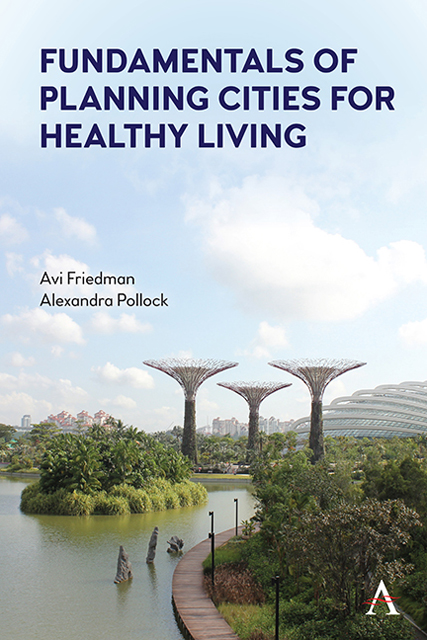Book contents
- Frontmatter
- Contents
- Preface
- Acknowledgments
- Chapter 1 The Broad View
- Chapter 2 Form, Function, and Public Health
- Chapter 3 Planning for Active Mobility
- Chapter 4 Green Open Spaces
- Chapter 5 Active Life in Winter Cities
- Chapter 6 Socializing in Communities
- Chapter 7 Food Production and Distribution
- Chapter 8 Urban Design for Healthy Aging
- Chapter 9 Public and Multi-Unit Residential Buildings and Public Health
- Chapter 10 Healthy Residences
- Chapter 11 Equitable Health Promotion
- Bibliography
- Bibliography for Case Studies
- Illustrations’ Credits
- Index
Chapter 3 - Planning for Active Mobility
Published online by Cambridge University Press: 10 January 2023
- Frontmatter
- Contents
- Preface
- Acknowledgments
- Chapter 1 The Broad View
- Chapter 2 Form, Function, and Public Health
- Chapter 3 Planning for Active Mobility
- Chapter 4 Green Open Spaces
- Chapter 5 Active Life in Winter Cities
- Chapter 6 Socializing in Communities
- Chapter 7 Food Production and Distribution
- Chapter 8 Urban Design for Healthy Aging
- Chapter 9 Public and Multi-Unit Residential Buildings and Public Health
- Chapter 10 Healthy Residences
- Chapter 11 Equitable Health Promotion
- Bibliography
- Bibliography for Case Studies
- Illustrations’ Credits
- Index
Summary
When residents can walk, cycle, or take public transit to work, stores, parks, and trails they are likely to have more opportunities for a healthy lifestyle. This chapter investigates how integrating suburban, rural, and urban areas through public transit, bike, and pedestrian paths can benefit public health. The chapter discusses transit-oriented development (TOD) and different methods for its implementation. It describes how successful urban design can promote safe active mobility and the importance of destination accessibility. The chapter ends with outlining the case of Västra Hamnen, a community near Malmö, Sweden, that was planned with shared streets.
3.1 The Built Environment and Active Mobility
As of 2018, 71.6 percent of adults in the United States were overweight or obese (Centers for Disease Control and Prevention (CDC) 2018). In Canada, this number was 63.1 percent (Statistics Canada 2018) and worldwide obesity has nearly tripled since 1975 (World Health Organization (WHO) 2020). There are genetic factors that lead to obesity, but one can also argue that what changed in the past century is our built environment and the subsequent limited lifestyle choices.
Characteristics associated with urban sprawl make places “obesogenic,” meaning they lead to obesity (Lee et al. 2011). Cities can be redesigned to give people choices in how they move around and where they can go. Increasing transportation options can address the services to which people have access, the health information they receive, and the food they eat by linking “food deserts” to better-resourced areas (Sallis and Glanz 2009).
Cities that facilitate healthy behavior are often compact, connected, with comfortable walking distances to and between amenities. These features are associated with higher rates of active mobility, defined as walking or bicycling for transportation, as single trips, or in combination with public transit (Wegener et al. 2017). Small changes in the built environment can make active mobility more convenient, faster, and safer and can encourage people to incorporate utilitarian physical activity (PA) into their daily lives. The ideal region is a well-connected network of “complete communities”: places where all residents have access to quality housing, education, employment opportunities, open space and recreation, places of worship, transportation, and health care (Vincent et al. 2012).
- Type
- Chapter
- Information
- Fundamentals of Planning Cities for Healthy Living , pp. 27 - 42Publisher: Anthem PressPrint publication year: 2022

